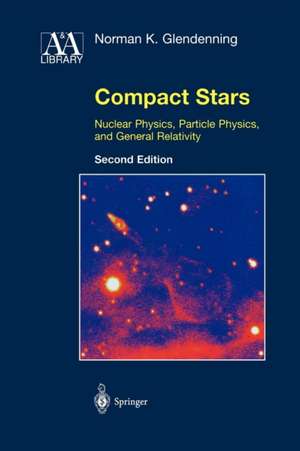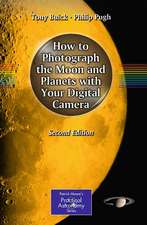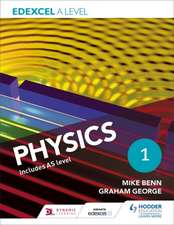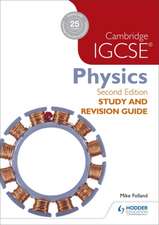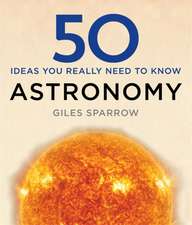Compact Stars: Nuclear Physics, Particle Physics, and General Relativity: Astronomy and Astrophysics Library
Autor Norman K. Glendenningen Limba Engleză Paperback – 27 sep 2012
| Toate formatele și edițiile | Preț | Express |
|---|---|---|
| Paperback (1) | 593.42 lei 6-8 săpt. | |
| Springer – 27 sep 2012 | 593.42 lei 6-8 săpt. | |
| Hardback (1) | 794.39 lei 6-8 săpt. | |
| Springer – 16 iun 2000 | 794.39 lei 6-8 săpt. |
Din seria Astronomy and Astrophysics Library
- 17%
 Preț: 496.37 lei
Preț: 496.37 lei - 15%
 Preț: 603.58 lei
Preț: 603.58 lei - 19%
 Preț: 455.24 lei
Preț: 455.24 lei - 17%
 Preț: 525.72 lei
Preț: 525.72 lei - 13%
 Preț: 393.37 lei
Preț: 393.37 lei - 19%
 Preț: 524.14 lei
Preț: 524.14 lei - 17%
 Preț: 393.90 lei
Preț: 393.90 lei - 15%
 Preț: 647.40 lei
Preț: 647.40 lei - 15%
 Preț: 541.54 lei
Preț: 541.54 lei - 17%
 Preț: 362.70 lei
Preț: 362.70 lei - 18%
 Preț: 1006.55 lei
Preț: 1006.55 lei - 18%
 Preț: 745.33 lei
Preț: 745.33 lei - 15%
 Preț: 641.20 lei
Preț: 641.20 lei -
 Preț: 397.38 lei
Preț: 397.38 lei - 15%
 Preț: 598.21 lei
Preț: 598.21 lei - 15%
 Preț: 658.05 lei
Preț: 658.05 lei - 23%
 Preț: 815.07 lei
Preț: 815.07 lei -
 Preț: 409.89 lei
Preț: 409.89 lei - 15%
 Preț: 610.61 lei
Preț: 610.61 lei -
 Preț: 393.90 lei
Preț: 393.90 lei - 15%
 Preț: 655.27 lei
Preț: 655.27 lei - 18%
 Preț: 951.47 lei
Preț: 951.47 lei - 18%
 Preț: 960.42 lei
Preț: 960.42 lei - 18%
 Preț: 1397.68 lei
Preț: 1397.68 lei - 18%
 Preț: 959.98 lei
Preț: 959.98 lei - 18%
 Preț: 1012.08 lei
Preț: 1012.08 lei - 15%
 Preț: 481.03 lei
Preț: 481.03 lei - 15%
 Preț: 672.43 lei
Preț: 672.43 lei -
 Preț: 413.15 lei
Preț: 413.15 lei - 18%
 Preț: 1554.72 lei
Preț: 1554.72 lei - 18%
 Preț: 1410.63 lei
Preț: 1410.63 lei -
 Preț: 390.08 lei
Preț: 390.08 lei - 18%
 Preț: 944.99 lei
Preț: 944.99 lei - 19%
 Preț: 502.94 lei
Preț: 502.94 lei - 15%
 Preț: 654.12 lei
Preț: 654.12 lei - 24%
 Preț: 851.62 lei
Preț: 851.62 lei - 19%
 Preț: 515.32 lei
Preț: 515.32 lei - 15%
 Preț: 663.14 lei
Preț: 663.14 lei - 15%
 Preț: 656.43 lei
Preț: 656.43 lei - 18%
 Preț: 741.68 lei
Preț: 741.68 lei - 15%
 Preț: 647.40 lei
Preț: 647.40 lei -
 Preț: 388.90 lei
Preț: 388.90 lei - 18%
 Preț: 1223.11 lei
Preț: 1223.11 lei - 15%
 Preț: 651.51 lei
Preț: 651.51 lei - 15%
 Preț: 655.27 lei
Preț: 655.27 lei -
 Preț: 347.59 lei
Preț: 347.59 lei - 18%
 Preț: 794.39 lei
Preț: 794.39 lei
Preț: 593.42 lei
Preț vechi: 698.13 lei
-15% Nou
113.55€ • 118.86$ • 94.51£
Carte tipărită la comandă
Livrare economică 01-15 aprilie
Specificații
ISBN-10: 1461270456
Pagini: 492
Ilustrații: XVIII, 468 p.
Dimensiuni: 155 x 235 x 26 mm
Greutate: 0.68 kg
Ediția:2nd ed. 2000. Softcover reprint of the original 2nd ed. 2000
Editura: Springer
Colecția Springer
Seria Astronomy and Astrophysics Library
Locul publicării:New York, NY, United States
Public țintă
GraduateCuprins
1 Introduction.- 1.1 Compact Stars.- 1.2 Compact Stars and Relativistic Physics.- 1.3 Compact Stars and Dense-Matter Physics.- 2 General Relativity.- 2.1 Relativity.- 2.2 Lorentz Invariance.- 2.2.1 Lorentz transformations.- 2.2.2 Covariant vectors.- 2.2.3 Energy and momentum.- 2.2.4 Energy-momentum tensor of a perfect fluid.- 2.2.5 Light cone.- 2.3 Scalars, Vectors, and Tensors in Curvilinear Coordinates.- 2.4 Principle of Equivalence of Inertia and Gravitation.- 2.4.1 Photon in a gravitational field.- 2.4.2 Tidal gravity.- 2.4.3 Curvature of spacetime.- 2.4.4 Energy conservation and curvature.- 2.5 Gravity.- 2.5.1 Mathematical definition of local Lorentz frames.- 2.5.2 Geodesics.- 2.5.3 Comparison with Newton’ gravity.- 2.6 Covariance.- 2.6.1 Principle of general covariance.- 2.6.2 Covariant differentiation.- 2.6.3 Geodesic equation from covariance principle.- 2.6.4 Covariant divergence and conserved quantities.- 2.7 Riemann Curvature Tensor.- 2.7.1 Second covariant derivative of scalars and vectors.- 2.7.2 Symmetries of the Riemann tensor.- 2.7.3 Test for flatness.- 2.7.4 Second covariant derivative of tensors.- 2.7.5 Bianchi identities.- 2.7.6 Einstein tensor.- 2.8 Einstein’ Field Equations.- 2.9 Relativistic Stars.- 2.9.1 Metric in static isotropic spacetime.- 2.9.2 The Schwarzschild solution.- 2.9.3 Riemann tensor outside a Schwarzschild star.- 2.9.4 Energy-momentum tensor of matter.- 2.9.5 The Oppenheimer-Volkoff equations.- 2.9.6 Gravitational collapse and limiting mass.- 2.10 Action Principle in Gravity.- 2.10.1 Derivations.- 2.11 Problems for Chapter 2.- 3 Compact Stars: From Dwarfs to Black Holes.- 3.1 Birth and Death of Stars.- 3.2 Objective.- 3.3 Gravitational Units and Neutron Star Size.- 3.3.1 Units.- 3.3.2 Size and number of baryons in a star.- 3.3.3 Gravitational energy of a neutron star.- 3.4 Partial Decoupling of Matter from Gravity.- 3.5 Equations of Relativistic Stellar Structure.- 3.5.1 Interpretation.- 3.5.2 Boundary conditions and stellar sequences.- 3.6 Electrical Neutrality of Stars.- 3.7 “Constancy” of the Chemical Potential.- 3.8 Gravitational Redshift.- 3.8.1 Integrity of an atom in strong fields.- 3.8.2 Redshift in a general static field.- 3.8.3 Comparison of emitted and received light.- 3.8.4 Measurements of M/R from redshift.- 3.9 White Dwarfs and Neutron Stars.- 3.9.1 Overview.- 3.9.2 Fermi-gas equation of state for nucleons and electrons.- 3.9.3 High- and low-density limits.- 3.9.4 Polytropes and Newtonian white dwarfs.- 3.9.5 Nonrelativistic electron region.- 3.9.6 Ultrarelativistic electron region: asymptotic white dwarf mass.- 3.9.7 Nature of limiting mass of dwarfs and neutron stars.- 3.9.8 Degenerate ideal gas neutron star.- 3.10 Improvements in White Dwarf Models.- 3.10.1 Nature of matter at dwarf and neutron star densities.- 3.10.2 Low-density equation of state.- 3.10.3 Carbon and oxygen white dwarfs.- 3.11 Temperature and Neutron Star Surface.- 3.12 Stellar Sequences from White Dwarfs to Neutron Stars.- 3.13 Baryon Number of a Star.- 3.14 Binding Energy of a Neutron Star.- 3.15 Star of Uniform Density.- 3.16 Scaling Solution of the OV Equations.- 3.17 Bound on Maximum Mass of Neutron Stars.- 3.18 Stability.- 3.18.1 Necessary condition for stability.- 3.18.2 Normal modes of vibration: Sufficient condition for stability.- 3.19 Beyond the Maximum-Mass Neutron Star.- 3.20 Black Holes.- 3.20.1 Interior and exterior regions.- 3.20.2 No statics within.- 3.20.3 Black hole densities.- 3.21 Problems for Chapter 3.- 4 Relativistic Nuclear Field Theory.- 4.1 Motivation.- 4.2 Lagrange Formalism.- 4.3 Symmetries and Conservation Laws.- 4.3.1 Internal global symmetries.- 4.3.2 Spacetime symmetries.- 4.4 Boson and Fermion Fields.- 4.4.1 Uncharged and charged scalar fields.- 4.4.2 Uncharged and charged vector fields.- 4.4.3 Dirac fields.- 4.4.4 Neutron and proton.- 4.4.5 Electromagnetic field.- 4.5 Properties of Nuclear Matter.- 4.6 The ? — ? Model.- 4.7 Stationarity of Energy Density.- 4.8 Model with Scalar Self-Interactions.- 4.8.1 Algebraic determination of the coupling constants.- 4.8.2 Symmetric nuclear matter equation of state.- 4.8.3 Negative self-interaction.- 4.9 Introduction of Isospin Force.- 4.10 Inclusion of the Octet of Baryons.- 4.11 High-Density Limit.- 4.12 Effective Versus Renormalized Theory.- 4.13 Bound Versus Unbound Neutron Matter.- 4.13.1 Bound neutron matter.- 4.14 Note on Dimensions.- 4.15 Summary.- 4.16 Problems for Chapter 4.- 5 Neutron Stars.- 5.1 Discovery.- 5.2 Pulsars: The Observational Basis of Neutron Stars.- 5.2.1 Important pulsar discoveries.- 5.2.2 Pulsar periods.- 5.2.3 Individual pulses and pulse profiles.- 5.2.4 Detection biases.- 5.2.5 Two populations of pulsars.- 5.2.6 Supernova associations with pulsars.- 5.2.7 Why pulsars are neutron stars.- 5.2.8 Mass of the Crab pulsar.- 5.2.9 Pulsar masses: observational.- 5.2.10 Pulsar masses: physical bounds.- 5.2.11 Neutron stars: a cosmic coincidence.- 5.2.12 Pulsar ages.- 5.2.13 Evolution of the braking index.- 5.3 Theory of Neutron Stars.- 5.3.1 Nuclear and neutron star matter: Similarities and differences.- 5.3.2 Chemical equilibrium in a star.- 5.3.3 Hadronic composition of neutron stars.- 5.3.4 Superdense matter.- 5.3.5 Neutron star matter.- 5.3.6 Hints for computation.- 5.3.7 Isospin- and charge-favored baryon species.- 5.3.8 Surface of neutron stars.- 5.3.9 Reprise of white dwarfs to neutron stars.- 5.3.10 Development of neutron star sequences.- 5.3.11 Mass as a function of central density.- 5.3.12 Radius—mass characteristic relationship.- 5.3.13 Limiting mass and the equation of state.- 5.4 Constitution of Neutron Stars.- 5.4.1 Beta equilibrium and symmetry energy.- 5.4.2 Hyperon stars.- 5.4.3 Hyperon coupling constants.- 5.4.4 Hyperon populations and the limiting mass.- 5.4.5 Compression modulus and effective nucleon mass.- 5.4.6 Charge neutrality achieved among baryons.- 5.4.7 Pion and kaon condensation.- 5.4.8 Condensation of Free Pions.- 5.5 Tables of Equations of State.- 5.5.1 Low density.- 5.5.2 High density.- 5.6 Problems for Chapter 5.- 6 Rotating Neutron Stars.- 6.1 Motivation.- 6.2 Dragging of Local Inertial Frames.- 6.3 Interior Solution for the Dragging Frequency.- 6.4 Moment of Inertia of a Rotating Relativistic Star.- 6.5 Kepler Angular Velocity in General Relativity.- 6.6 Effect of Frame Dragging on Kepler Frequency.- 6.7 Approximation to the Kepler Frequency.- 6.8 Hartle—Thorne Perturbative Solution.- 6.8.1 Comparison of Perturbative and Numerical Solutions.- 6.9 Imprint of Angular Momentum.- 6.10 Rotating Stars with Realistic Equations of State.- 6.11 Effect of Rotation on Stellar Structure.- 6.12 Gravitational-Wave Instabilities.- 6.13 Problems for Chapter 6.- 7 Limiting Rotational Period and Radius of Neutron Stars.- 7.1 Motivation.- 7.2 The Minimal Constraints.- 7.3 Variational Ansatz.- 7.4 Limiting Value of Rotational Period as a Function of Mass.- 7.5 Test of Sensitivity of Results.- 7.6 General Relativistic Limit on Rotation.- 7.7 Lower Limit on Neutron Star Radius.- 7.8 Discussion and Alternatives.- 7.9 Self-Bound Stars.- 7.10 Summary.- 8 Quark Stars.- 8.1 Introduction.- 8.2 Model of Quark Confinement.- 8.3 Quark Matter Equation of State.- 8.3.1 Zero temperature.- 8.3.2 Massless quark approximation.- 8.3.3 First order in ?s.- 8.4 Quark Star Matter.- 8.5 Strange and Charm Stars.- 8.5.1 General considerations.- 8.5.2 Strange quark matter.- 8.5.3 Stability considerations.- 8.6 Problems for Chapter 8.- 9 Hybrid Stars.- 9.1 Introduction.- 9.2 Constant-Pressure Phase Transition.- 9.2.1 Purely neutron star.- 9.2.2 Enforced local charge neutrality.- 9.3 The Confined—Deconfined Phase Transition in Neutron Stars.- 9.3.1 Conservation laws are global—not local.- 9.3.2 Degrees of freedom in a multicomponent substance.- 9.3.3 Nuclear symmetry energy and a coulomb lattice.- 9.3.4 Phase diagram.- 9.3.5 Two energy scales.- 9.4 Large-Scale Structure of a Hybrid Star.- 9.4.1 Energy budget in the reapportionment of charge.- 9.5 Crystalline Structure of the Mixed Phase.- 9.5.1 Crystalline structure as a function of stellar mass.- 9.5.2 Possible implications for glitches.- 9.6 Tables of Equation of State for Hybrid Stars.- 9.7 Problems for Chapter 9.- 10 Bose Condensates in Neutron Stars.- 10.1 Relativistic Mean—Field Model with Kaons.- 10.2 Equation of State with a Kaon Condensate.- 10.2.1 Maxwell versus Gibbs.- 10.2.2 Dependence on parameters.- 10.2.3 Particle populations.- 10.2.4 Comment on coupling schemes.- 10.2.5 Comment on hyperons.- 10.2.6 Mixed-phase properties.- 10.3 Stellar Properties.- 10.3.1 Large-scale features.- 10.3.2 Geometrical structure in the mixed phase.- 10.3.3 Pulsar glitches.- 10.4 Summary.- 10.5 Problems for Chapter 10.- 11 Consequences and Signals of Phase Transitions.- 11.1 Introduction.- 11.2 Mechanism for Formation of Low-Mass Black Holes.- 11.2.1 Hyperonization-induced collapse.- 11.2.2 Deconfinement-induced collapse.- 11.2.3 Density profiles.- 11.2.4 Discussion.- 11.3 A Third Class of Stable Compact Stars.- 11.3.1 Introduction.- 11.3.2 Stability of nonidentical twins.- 11.3.3 Cause of stability of a third class of stars.- 11.3.4 Detection and formation mechanisms.- 11.3.5 Conclusions and prospects.- 11.4 Phase Transition Signal in Pulsar Timing.- 11.4.1 Evolutionary path of neutron stars.- 11.4.2 Calculation.- 11.4.3 Spin-up era.- 11.4.4 X-ray pulsars in low-mass binaries.- 11.5 Caveats.- 12 Strange Stars.- 12.1 The Strange Matter Hypothesis.- 12.2 Compatibility of the Hypothesis with Present Knowledge.- 12.2.1 Energetic considerations.- 12.2.2 The universe and its evolution.- 12.2.3 Stability of nuclei against decay to strange matter.- 12.2.4 Stability of nuclei to conversion by strange nuggets.- 12.2.5 Terrestrial searches.- 12.2.6 Summary, prospects, and challenges.- 12.3 Submillisecond Pulsars.- 12.3.1 The fine-tuning problem.- 12.3.2 Limits to neutron star rotation.- 12.3.3 Implausibly high central densities.- 12.3.4 Strange stars as fast rotors.- 12.3.5 Out of the impasse.- 12.3.6 Motivation for searches and prospects for discovery.- 12.4 Structure of Strange Stars.- 12.5 Simultaneous Existence of Strange and Neutron Stars.- 12.6 Strange Stars to Strange Dwarfs.- 12.6.1 Strange stars with nuclear crusts.- 12.6.2 Nuclear crust and pulsar glitches.- 12.6.3 Strange dwarfs with nuclear crusts.- 12.6.4 Stability.- 12.6.5 Possible new class of dense white dwarfs.- 12.7 Conclusion.- Useful Astronomical Data.- Books for Further Study.- References.
Recenzii
"Deals thoroughly with the equations of state, the structure and constitution of white dwarfs, and neutron stars ... It contains material that can be hard to find elsewhere."
THE OBSERVATORY
Descriere
White dwarfs, neutron stars, and (solar mass) black holes are the collapsed cores of stars which, near the ends of their luminous lives, have shed most of their mass in supernova explosions or other, less spectacular, instabilities. Here gravity crushes matter to realms that lie far beyond present empirical knowledge. This book explores the diverse forms that such compact stars can possibly take, as constrained by the laws of nature: the general principles of relativity and quantum mechanics, the properties of nuclear matter deduced from nuclei, and the asymptotic freedom of quarks at high density. The book is self contained. It reviews general relativity, essential aspects of nuclear and particle physics, and general features of white dwarfs, neutron stars and black holes; it includes background on such matters as stellar formation and evolution, the discovery of pulsars and associated phenomena, and the strange-matter hypothesis. The book develops a theory for the constitution of neutron stars and the more exotic Hyperon Stars, Hybrid Stars (containing a quark matter core surrounded by an intricate lattice of quark and hadronic matter) and Strange Stars and Dwarfs (composed of the three light quark flavors sheathed in a solid skin of heavy ions). This second edition has been revised throughout to clarify discussions and bring data up to date; it includes new figures, several new sections, and new chapters on Bose condensates in neutron stars and on phase transitions.
